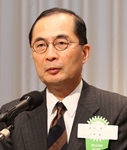��Vocational Service Month��
MeetingPresent Situation and Challenges of the Japanese Economy
October 9, 2013
Mr. Hiroshi Yoshikawa
Graduate School of Economics,
Faculty of Economics,
The University of Tokyo
�� We hear many people say that the Japanese economy seems to be picking up, thanks to the so-called Abenomics economic policies advocated by Prime Minister Shinzo Abe. It is true that we are seeing an upturn in economic conditions since last November. My speech today, however, will focus on the sense of uneasiness and stagnation that distress people in Japan amidst the current positive economic climate as well as possible countermeasures that need to be taken.
We hear many people say that the Japanese economy seems to be picking up, thanks to the so-called Abenomics economic policies advocated by Prime Minister Shinzo Abe. It is true that we are seeing an upturn in economic conditions since last November. My speech today, however, will focus on the sense of uneasiness and stagnation that distress people in Japan amidst the current positive economic climate as well as possible countermeasures that need to be taken.
��If I may begin from the conclusion, I believe ��social security�� and ��innovation�� are the two key elements that can reconstruct the Japanese economy. ��Social security�� is a rather defensive measure, while ��innovation�� is more aggressive, yet both are essential to overcome the challenging issues we face in our economy and society. As we all know, the social security costs are already overstrained and there await various challenging issues to be addressed. In the end, I believe that how to promote ��innovation�� is vital for the future of Japan.
��Now, what makes many feel uneasiness and stagnation? One factor is the widening economic disparities due to aging society with fewer children, as the gap in wealth is wider among the aged than the younger generation. Change in the family structure and prolonged economic stagnation since the collapse of the economic bubble have also triggered overall uncertainty.
��Let me give you some statistical figures on socioeconomic disparity that reveal a somewhat surprising picture. Statistics on the ��top income shares (top 0.1% income earners)�� over the past 100 years among the world��s major industrial countries show that super-rich families had existed in all countries before World War II. For example, Henry Ford, J.P. Morgan or Rockefeller had built enormous wealth in the US around the 1930s and there existed the zaibatsu (financial conglomerates) in Japan. Interestingly enough, all such super-rich families disappeared after World War II, indicating the world has become more equalized to a certain degree. We have a totally different picture after the 1980s, where top income shares are increasing substantially and widening the gap in wealth, most explicitly observed in the US. In contrast, Japan and Continental European countries experience very modest increases in top income shares.
��Another figure I want to quote is the income distribution pattern of Japan that indicates an overall downturn after the bubble economy burst that can lead to the impoverishment of the country as a whole.
��Japan faces various challenging issues of disparity, aging of population and economic recession that cause a sense of stagnation. Although there is no silver-bullet solution to these complicated issues, I believe we can mitigate the problems by taking effective measures on social security. The prolonged deflation in our country also causes uneasiness. An intense debate unfolds among economists on its solution and some insist monetary easing measures will be the best solution, yet I am skeptical. It is because I believe wage decline is the root-cause of deflation in Japan. As the international comparison on nominal wages indicates, wages in Japan continue to decline while they are constantly growing in the US and eurozone nations and the gap keeps widening.
��Population decrease is often blamed as a cause of economic slowdown, but I am totally against such a claim. Economic growth in developed nations has nothing to do with its population size. Looking at the demographic change and real GDP growth in Japan from around 1870 to 1990, GDP soared while our population growth was marginal, proving these two elements are nonrelated. A country becomes economically developed when its productivity improves through technological innovation and its income per capita rises.
��Let me share with you another figure on the growth rate of Japan during its high economic growth period in the mid-1960s. When Japan hosted the 1964 Tokyo Olympic Games, its economic growth rate in real terms reached around 10%. You might be surprised to know that the yearly growth rate of labor force population was a little over 1% back then. In other words, 10% economic growth was generated by just 1% growth in our labor force population. Now, what brought this difference of 9% growth? The explanation in economic terms is that capital and equipment investments achieved innovation that led to ��growth in labor productivity.��
��Before closing, let me clarify that when I say population and economy are two separate issues, I don��t mean to say that population decrease itself is not a major issue. Actually, it entails serious consequences that call for immediate countermeasures. Having said that, let me reiterate that innovation is the key element that will bring economic growth to our country, regardless of our population size in the future.